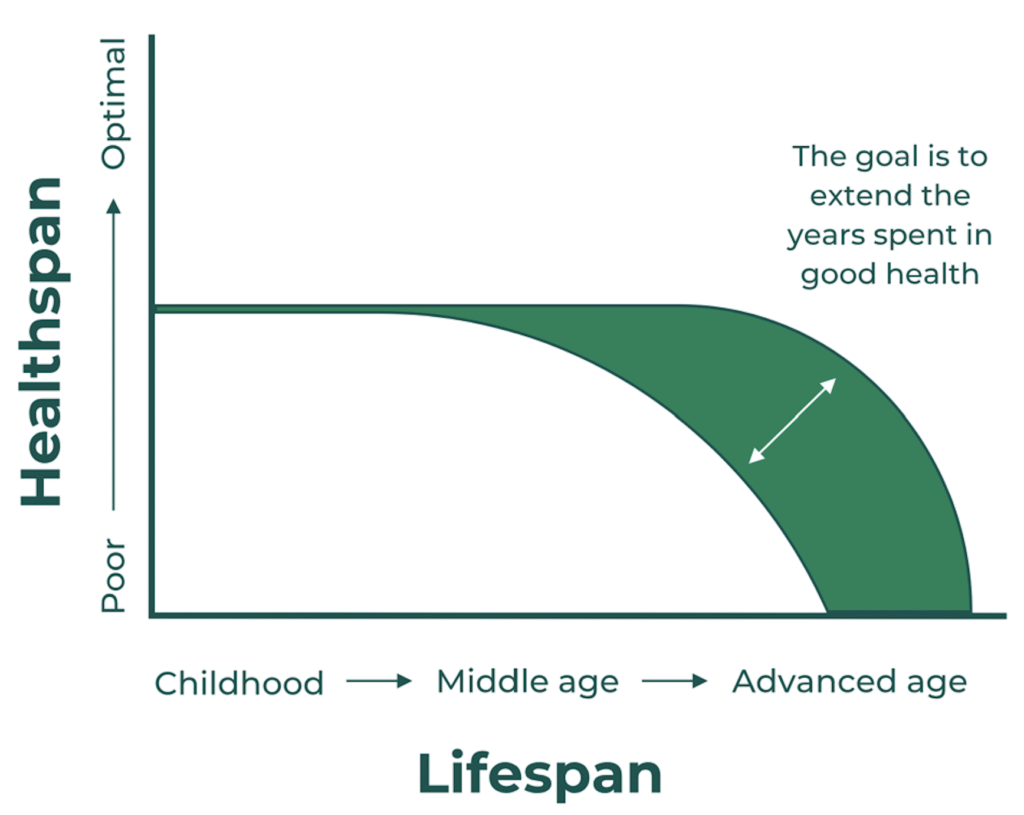Every day in emergency departments around the world, the toll of aging is evident: falls, fractures, strokes, and heart attacks in older adults. Even when patients survive the initial event, hospital stays are often prolonged. Rehabilitation may follow, but in many cases, the result is a permanent loss of independence. These outcomes are frequently the consequence of years—sometimes decades—of gradual declines in strength, mobility, nutrition, cognitive capacity, and social connection. What’s needed is a new approach to healthy aging.
This is because traditional medicine often intervenes only after a health crisis has occurred. This reactive model is increasingly out of step with the science of aging. Longevity experts like Dr. Peter Attia argue that a more modern, preventive approach is essential—one that prioritizes quality of life rather than just a longer life.
In Healthy Aging, The Goal Should Be to Improve Quality of Life, Not Just Extend It
Extending lifespan—the number of years lived—has long been the primary focus of medical interventions. But without attention to healthspan—the number of years lived in good physical, cognitive, and emotional health—additional years may come at the cost of independence, dignity, and well-being.

Modern medicine excels at prolonging life through medications, surgeries, and advanced technologies. Yet many of these interventions do little to preserve vitality or prevent the cascade of disability that often follows acute illness. A more meaningful goal is to extend healthspan by investing earlier in strategies that support strength, cognition, and emotional resilience.
Resistance Training: A Cornerstone of Healthy Aging
Skeletal muscle mass begins to decline as early as the third decade of life. This process accelerates with age and contributes directly to markers of poor health including frailty, loss of mobility, insulin resistance and an increased risk of hospitalization and death.
Muscle is not only critical for movement but also functions as a metabolic reserve, supporting immune function, glucose regulation, and even cognitive health. Yet resistance training remains underutilized in older adults, often due to the outdated belief that strength training is only appropriate for the young or athletic.
The LIFTMOR trial challenged this assumption. Postmenopausal women with low bone density were randomized to either high-intensity supervised resistance training or low-intensity home exercise. Over eight months, those in the high-intensity group saw a 3% increase in spine and leg bone density, compared to a 1% loss in the control group. Importantly, adverse events were rare—demonstrating that, when done correctly, lifting heavy weights is both safe and effective in older populations.
Integrating resistance training into routine care for older adults could significantly reduce falls, lower hospitalization rates, and preserve independence for years.
Falls: A Preventable Epidemic
Falls are the leading cause of accidental death among adults over age 65. Even nonfatal falls often result in hospitalization, surgery, and long-term loss of function. In many cases, mobility is never fully regained.
Fall risk is not only a function of age. It is largely driven by the loss of fast-twitch muscle fibers—responsible for explosive movements—and declines in reactivity, or the ability to respond quickly to a threat, such as a misstep on uneven ground.
Both of these can be improved through targeted training. Programs that incorporate heavy resistance training, dynamic balance work, and functional movement patterns—like squats and lunges—can substantially reduce fall risk. Physical fitness in older adults should not be viewed as optional, but rather as a core component of preventive care.
Protein: The Undervalued Nutrient in Healthy Aging
With age, the body becomes less efficient at synthesizing muscle from dietary protein, a phenomenon known as anabolic resistance. As a result, older adults require more protein than younger individuals to maintain or build muscle mass—potentially up to one gram per pound of body weight.
Insufficient protein intake accelerates sarcopenia, or muscle wasting, which in turn increases vulnerability to illness, injury, and functional decline. A more intentional focus on protein intake—especially in those recovering from hospitalization—could serve as a low-cost, high-yield intervention to support independence and reduce healthcare utilization.
Social and Emotional Health Are Central to Healthy Aging
While physical and cognitive health receive significant attention, emotional well-being is often overlooked. Loneliness, isolation, and lack of purpose are all linked to worse health outcomes and higher mortality.
Community living environments offer built-in opportunities for social connection, but many older adults age in place, where the risk of isolation grows over time. Incorporating social health assessments, fostering intergenerational interaction, and designing communities that encourage engagement are essential strategies for promoting long-term well-being.
From Emergency Response to Systems For Healthy Aging
The aging population presents an urgent challenge — and a powerful opportunity — to redesign care systems. Health systems must expand their focus beyond acute care to include early identification of risk factors, promotion of physical activity, optimization of nutrition, and support for emotional health. One such approach is Dr. Attia’s centenarian decathlon which is described here.
Nevertheless, such a shift requires action at every level—from primary care to emergency medicine, from insurers to policymakers. It means building infrastructure that supports proactive aging strategies and redefining what successful aging looks like.
The science of healthy aging is clear: with the right interventions, older adults can live not only longer lives, but also healthier and more fulfilling ones. Strength training, adequate protein, social connection, and a preventive mindset can reshape the aging experience. It is time for healthcare systems and society at large to align with this evolving understanding — and to act accordingly.
